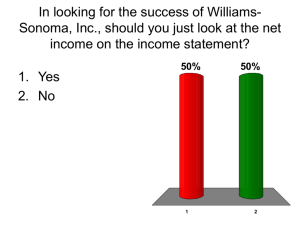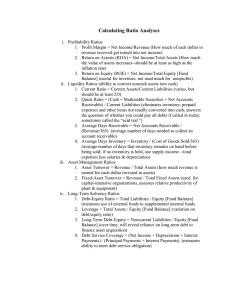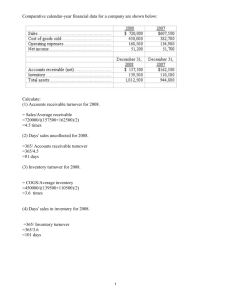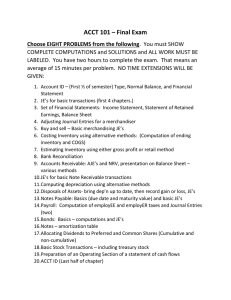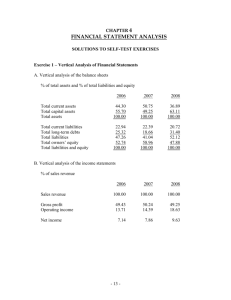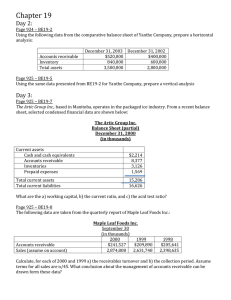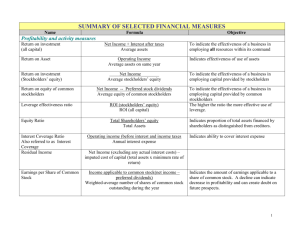Problem 14-11A: Part 1
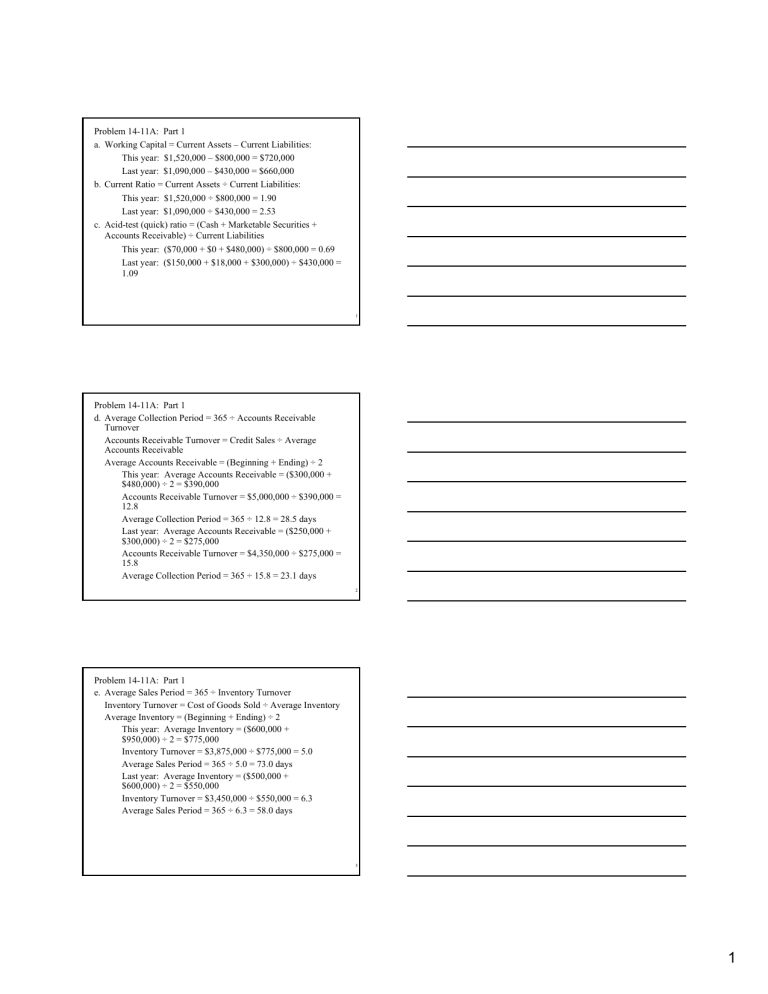
Problem 14-11A: Part 1 a. Working Capital = Current Assets – Current Liabilities:
This year: $1,520,000 – $800,000 = $720,000
Last year: $1,090,000 – $430,000 = $660,000 b. Current Ratio = Current Assets ÷ Current Liabilities:
This year: $1,520,000 ÷ $800,000 = 1.90
Last year: $1,090,000 ÷ $430,000 = 2.53
c. Acid-test (quick) ratio = (Cash + Marketable Securities +
Accounts Receivable) ÷ Current Liabilities
This year: ($70,000 + $0 + $480,000) ÷ $800,000 = 0.69
Last year: ($150,000 + $18,000 + $300,000) ÷ $430,000 =
1.09
1
Problem 14-11A: Part 1 d. Average Collection Period = 365 ÷ Accounts Receivable
Turnover
Accounts Receivable Turnover = Credit Sales ÷ Average
Accounts Receivable
Average Accounts Receivable = (Beginning + Ending) ÷ 2
This year: Average Accounts Receivable = ($300,000 +
$480,000) ÷ 2 = $390,000
Accounts Receivable Turnover = $5,000,000 ÷ $390,000 =
12.8
Average Collection Period = 365 ÷ 12.8 = 28.5 days
Last year: Average Accounts Receivable = ($250,000 +
$300,000) ÷ 2 = $275,000
Accounts Receivable Turnover = $4,350,000 ÷ $275,000 =
15.8
Average Collection Period = 365 ÷ 15.8 = 23.1 days
2
Problem 14-11A: Part 1 e. Average Sales Period = 365 ÷ Inventory Turnover
Inventory Turnover = Cost of Goods Sold ÷ Average Inventory
Average Inventory = (Beginning + Ending) ÷ 2
This year: Average Inventory = ($600,000 +
$950,000) ÷ 2 = $775,000
Inventory Turnover = $3,875,000 ÷ $775,000 = 5.0
Average Sales Period = 365 ÷ 5.0 = 73.0 days
Last year: Average Inventory = ($500,000 +
$600,000) ÷ 2 = $550,000
Inventory Turnover = $3,450,000 ÷ $550,000 = 6.3
Average Sales Period = 365 ÷ 6.3 = 58.0 days
3
1
Problem 14-11A: Part 1 f. Debt-to-Equity Ratio = Total Liabilities ÷ Stockholders’ Equity
This year: $1,400,000 ÷ $1,600,000 = 0.875
Last year: $1,030,000 ÷ $1,430,000 = 0.720
g. Times Interest Earned Ratio = Net Income Before Interest and
Taxes ÷ Interest Expense
This year: $472,000 ÷ $72,000 = 6.6
Last year: $352,000 ÷ $72,000 = 4.9
4
Part 2:
Current Assets:
Cash
Marketable securities
Accounts receivable
Inventory
Prepaid expenses
Total current assets
Plant and equipment (net)
Total assets
Sabin Electronics
Common-Size Balance Sheets
This year
2.3%
0.0%
16.0%
31.7%
0.7%
50.7%
49.3%
100.0%
Current liabilities
Bonds payable
Total liabilities
Stockholders’ equity
Preferred stock, $25 par, 8%
Common stock, $10 par
Retained earnings
26.7%
20.0%
46.7%
8.3%
16.7%
28.3%
Total stockholders’ equity 53.3%
Total liabilities and stockholders’ equity 100.0%
Last year
6.1%
0.7%
12.2%
24.4%
0.9%
44.3%
55.7%
100.0%
17.5%
24.4%
41.9%
10.2%
20.3%
27.6%
58.1%
100.0%
5
Part 2:
Sales
Cost of goods sold
Gross margin
Operating expenses
Net operating income
Interest expense
Net income before taxes
Income taxes
Net income
Sabin Electronics
Common-Size Income Statements
This year
100.0%
77.5%
22.5%
13.1%
9.4%
1.4%
8.0%
2.4%
5.6%
Last year
100.0%
79.3%
20.7%
12.6%
8.1%
1.7%
6.4%
1.9%
4.5%
6
2
Part 3:
Ratios:
Although the company’s working capital increased, its current and quick ratios significantly decreased from 2.53 to 1.90 and 1.09 to 0.69 respectively. Last year, both ratios were consistent with the industry averages, but are now well below the industry averages. Unless the company takes action immediately, it could well find itself unable to pay its bills as they come due.
The average collection period and average sales period both increased from last year to the current year. The average collection period moved from 23.1 days to 28.5 days indicating that on average, customers are taking longer to pay. In addition, with the credit terms of 2/10, n/30, the average collection period for both years shows that customers are not taking advantage of the credit terms. For both years, the average collection period was greater than the industry average. This may be the result of financial problems being experienced by the customers, or customers who are poor credit risks. The average sales period increased significantly from 58 days to 73 days, compared to the industry average of 60 days. This indicates that the company is holding its inventory longer than in the previous year, and longer than comparable companies.
The debt-to-equity ratio increased from 0.72 to 0.875, but is still below the industry average of 0.90, as is the times interest earned ratio.
7
Part 3:
Income Position:
Not withstanding the just discussed problems that the company appears to be experiencing, its income position appears to be good. The gross margin improved from 20.7% to 22.5%. Although the operating expenses increased as a percentage of sales, the overall operating income improved primarily because of the improvement in gross margin.
Should the loan be approved?
Given the current situation, the loan should not be approved. If, however, the company is able to get its accounts receivable and inventory under control, then the company’s cash position should improve, and it should be able to handle the added debt. If the cash position improved enough, the loan may not be needed.
8
3
